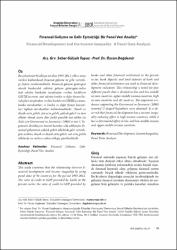| dc.contributor.author | Topuz, Seher Gülşah | |
| dc.contributor.author | Dağdemir, Özcan | |
| dc.date.accessioned | 2020-12-10T08:20:15Z | |
| dc.date.available | 2020-12-10T08:20:15Z | |
| dc.date.issued | 2016 | en_US |
| dc.identifier.citation | Topuz, S: G, Dağdemir, Ö. (2016). Finansal gelişme ve gelir eşitsizliği: Bir panel veri analizi. Anadolu Üniversitesi Sosyal Bilimler Dergisi, 16 (3), 19-34. | en_US |
| dc.identifier.issn | 2667-8683 | |
| dc.identifier.uri | https://hdl.handle.net/11421/25193 | |
| dc.description.abstract | Bu çalışmada 94 ülkeye ait olan 1995-2011 yılları arası
verileri kullanılarak finansal gelişme ve gelir eşitsizliği ilişkisi incelenmektedir. Finansal gelişme göstergesi
olarak bankacılık sektörü gelişim göstergelerinden
özel sektöre bankalar tarafından verilen kredilerin
GSYİH’ya oranı, özel sektöre banka ve diğer finans kuruluşları tarafından verilen kredilerin GSYİH’ya oranı,
banka mevduatları ve banka ve diğer finans kurumları toplam mevduatları kullanılmaktadır. Düşük ve
düşük-orta gelirli, üst-orta gelirli, yüksek gelirli ve tüm
ülkeler olmak üzere dört farklı panelde test edilen bu
ilişki için Greenwood ve Jovanovic (1990)’in ters-U hipotezini destekleyen önemli kanıtlar elde edilmiştir. Finansal gelişmenin yüksek gelirli ülkelerde gelir eşitsizliğini azaltıcı, düşük ve düşük-orta gelirli, üst-orta gelirli
ülkelerde ise arttırıcı etkisi olduğu görülmektedir. | en_US |
| dc.description.abstract | This study examines that the relationship between financial development and income inequality by using
panel data of 94 countries for the period 1995-2011.
The ratio of credit to GDP provided by banks to the
private sector, the ratio of credit to GDP provided by
banks and other financial institutions to the private
sector, bank deposits and total deposits of bank and
other financial institutions are used as financial development indicators. This relationship is tested for four
different panels that is divided as low and low-middle
income countries, upper-middle income countries, high
income countries and all countries. The important evidences supporting the Greenwood ve Jovanovic (1990)
inverted U-shaped hypothesis were obtained. It is observed that financial development has a income inequality-reducing effect in high income countries, while it
has a detrimental effect in low and low-middle income
and upper-middle income countries. | en_US |
| dc.language.iso | tur | en_US |
| dc.publisher | Anadolu Üniversitesi | en_US |
| dc.rights | info:eu-repo/semantics/openAccess | en_US |
| dc.subject | Finansal Gelişme | en_US |
| dc.subject | Gelir Eşitsizliği | en_US |
| dc.subject | Panel Veri Analizi | en_US |
| dc.subject | Financial Development | en_US |
| dc.subject | Income Inequality | en_US |
| dc.subject | Panel Data Analysis | en_US |
| dc.title | Finansal gelişme ve gelir eşitsizliği: Bir panel veri analizi | en_US |
| dc.title.alternative | Financial development and the income inequality: A panel data analysis | en_US |
| dc.type | article | en_US |
| dc.relation.journal | Anadolu Üniversitesi Sosyal Bilimler Dergisi | en_US |
| dc.contributor.department | Anadolu Üniversitesi | en_US |
| dc.identifier.volume | 16 | en_US |
| dc.identifier.issue | 3 | en_US |
| dc.identifier.startpage | 19 | en_US |
| dc.identifier.endpage | 34 | en_US |
| dc.relation.publicationcategory | Makale - Ulusal Hakemli Dergi - Başka Kurum Yazarı | en_US |


















